
These two items are quite famous.
Almost associated with the Swiss brand.
But does Switzerland have a reasonable military of its own?
The strength of Swiss military is about 100000, with another 100000 available as reservist. It does not have a commander-in-chief in the peace time.
Then, how come the Swiss military brands has so much visibility?
The story is as old as Swiss federal system known as the Swiss Confederation.
Once upon a time Switzerland used to supply mercenaries to all European forces. And in the medieval battle fields, they were considered quite proficient soldiers. They used pikes and long axes (known as halberd) to form columns that would thrust in unison to pierce and destroy the enemy infantry and cavalry. In the preindustrial age, the mountainous regions of Alps were poverty stricken, and being a mercenary was a good, even sought-after, occupation- Either way one will die. You choose to die of poverty or die in battle, but make some money and prestige until you are dead.
As the Swiss mercenaries were in demand on both sides of the warring European monarchs, they preferred to keep Switzerland neutral in their conflicts. in any case, there is nothing worth capturing in these underpopulated mountainous terrains. Also, earlier attempts of Swiss rulers for expansion of territories ended in summary defeat at the hands of the French.
As mercenary business was a mainstay source of income, the regions that would form the Swiss confederation made neutrality as their trade mark.
Meanwhile, a religious inflight (what the church historians call as ‘schism’) would split Europe. A German priest named Martin Luther raised an open rebellion against the Church. One of his principal rallying point was against a practice known as ‘Indulgence’.
According to church’s doctrine the Church had accumulated a ‘treasury of merit’ accumulated based on the suffering Jesus Christ and his follower-martyrs (Like Saint Peter) bore in the early era of Christanity. This ‘virtue points’ church could choose to sell in return of atoning sins of layman. Here, Church was almost like a bank that took away sins for a payment. The sinner could pay the church to get himself free of sins. It was quite a transactional relationship between the Church and the layman who would sin in their course of life. Church had a list of sins according it theology based on Ten commandants and ever-increasing volumes of interpretation around it.

The church would use the fund so generated to fund grand construction like the St Peter’s Basilica in Rome. The Pope’s palaces in Rome itself were a testimony of the opulence of the popes of medieval times. Pope commissioned highly regarded artists like Michelangelo, Raphel and Da Vinci to erect and decorate Church’s buildings.
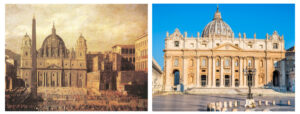
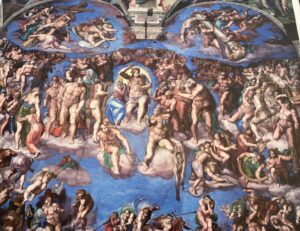
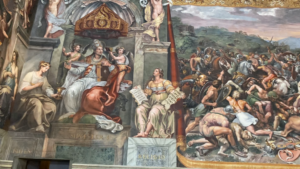
Many princes in the German speaking regions would side with Martin Luther and become Protestants kingdoms. France and regions of present day Italy would side with the catholic church in Rome. This would create a fissure in the conflicts in Europe. The Protestants kingdoms would fight against Catholic Kingdoms. Catholic regimes would initiate persecution against suspected Protestant sympathiser in their reign. Protestants in-turn were rebel groups who want to make more and more converts to their side, firmly believing that Catholics were sinners who need ‘reformation’. This created tension in European states that many a times reached flash points. A situation emerged in 1572 in Paris, when the tension in France between Protestant sympathisers called Huguenots and Monarch reached at a boiling point that King Charles IX and her mother Catherine de Medici would order a massacre of Huguenots in Paris. About 70,000 Huguenots perished in the massacre (known as St Bartholomew Day massacre).
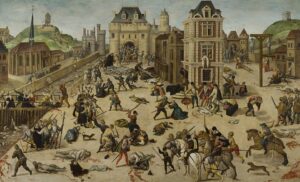
This would incite an exodus of refugees to neutral Switzerland, mainly to Geneva. Many of these people who fled were highly skilled technicians, artisans and bankers. They brought their skills to their land of adaption.
The origin of watch making in Switzerland dates back to Huguenots refugees from France. So is banking.
Meanwhile, the Protestant theologian-cum-lawyer, John Calvin, operating from Geneva, would provide theological support for accepting banking interests for Christians. Until then usury was prohibited in Christianity, and Jews were the main community engaged in banking.
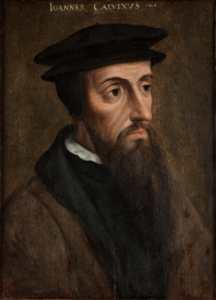
This is a major breakthrough act that would become open banking as an acceptable profession for devout Christians. Also, as Protestants are supposed to read bible on their own (without the mediation of a clergy, unlike the catholic church’s stipulation) literacy become of paramount importance. Public education was made compulsory in Geneva where these reforms were first initiated. In turn, there was massive translation exercise under the guidance of John Calvin. One of the many language translations of the Bible, the English translation, otherwise known as the Geneva Bible, would be one of the documents the Puritan ‘pilgrims’ who would travel to America to found English settlements in America.

Protestant ideology would denounce mercenary work as an indecent occupation. However, there were cantons (relatively autonomous administrative subdivision in Swiss federal system) near the mountains who wanted to keep mercenary job opportunities to sustain their economy. These cantons like Uri, Schwyz, Lucerne, Unterwalden and Zug engaged in war with the ‘reformed’ Protestant cantons, in guise of upholding Catholic ideology. These League of the Five Cantons would protest against the expansion of the Protestant ideology. There were multiple wars between these alliances. In 1768, French army under Napoleon conquered Switzerland and the confederation of Canton was abolished. However, it remained a battle ground of French and other imperial European forces until the Napoleon agreed to partially restore powers of Swiss confederation. In 1814-15, with the Congress of Vienna, convened after the defeat of Napoleon, the neutrality of the Swiss cantons was guaranteed by the victorious European powers.

During the interlude of conflicts of opposing theology in Swiss cantons, there was Counter Reformation movement in Catholic cantons. While originally church and the civil administration of the canton was identical, with huge amount of corruption and debauchery in the clergy communities, the Counter Reformation induced separation of these functions, and a council of civil authorities started to function as the main civil administrators, separating the church from civil administration. This is an important event that set in slowly the evolution of secular states in Europe as the reformation-counter reformation movement was playing out.
With the acceptance of the Swiss neutrality by European power in a formal treaty at the Congress of Vienna, the already established Swiss banks (thanks to Huguenots who had taken refuge in Switzerland), started to promote the security of its banks to wealthy clients in the still warring European countries. The elites who were concerned about the exorbitant taxes imposed for funding European wars found the security provided by Swiss neutrality as an avenue to secure their wealth. French royalty, military generals and even Bishops had secret accounts in Swiss banks.
Thus, while the mercenary trade was central to Swiss neutrality in the medieval era, by 19th century the Swiss banking became the core driving force of its neutrality.
In 1934, Swiss banking laws was formulated that made violation of banking secrecy as a criminal offence. Confidentiality and secrecy thus developed as a hallmark of Swiss banks.
In the runup to the World War II, Nazis deposited huge amount of wealth in the Swiss banks. This included wealth confiscated from subjects of their persecution. Adolf Holter himself had $ 1 billion worth of assets. Nevertheless, Hitler had plans to invade Switzerland. He wanted to reform the German-speaking citizens of Switzerland and divide the country between Germany and Italy. However, the distraction in the war due to the Allied invasion of Normandy, and the reversals in the eastern war with the Soviet Union, made the Nazis to defer the operation. In fact, the signs of reversals in the war would have itself become a reason to spare Switzerland invasion as Swiss banks was a principal conduit of exchanging funds to its ally, Italy. The wealth the Nazis deposited in the Swiss banks is also one of the reasons cited.
In its 90 years history since the formulation of banking laws, Swiss banking secrecy norms was violated only 4 times.
In all but one times, the whistle-blowers had their livelihood at stake, having to leave the heaven on earth, and mostly live under the thread of litigation and constant surveillance.
In one instance, however, the whistle-blowers had his share of limelight and livelihood: In 1998, Christoph Meili, working as a security guard in Union Bank of Switzerland disclosed to a Jewish community organization of Nazi ledgers of properties confiscated from Jews in Germany. Meili found them as these documents were taken out to be shredded. An investigation on these documents uncovered the wealth Nazis expropriated from the Jews who died in the Holocaust. The sensitivity of Holocaust made the bank open up for a thorough investigation and indeed paid reparation amounting to $1.4 billion settlement to the Holocaust survivors and their families. However, Meili could not live in Switzerland after the disclosure due to community reprimand. He was given a US asylum.

Yielding to break of secrecy code with respect to Nazi blood money seems to an exception than the rule, as the fate of other whistleblowing episodes demonstrate – These involve Herve Falcani, Bradley Birkenfeld and Rudolf Elmer. All of them had a miserable life involving multiple arrest and litigations. The whistle-blowers are penalised heavily and they may not be able to live in Switzerland anymore due to strong community disapproval. The secrecy code stands against the tenets of press freedom. But for an economy fuelled by financial organisations, is an essential breach of the community’s social contract.
Hits: 137

